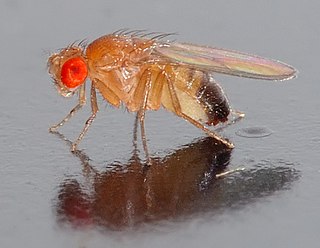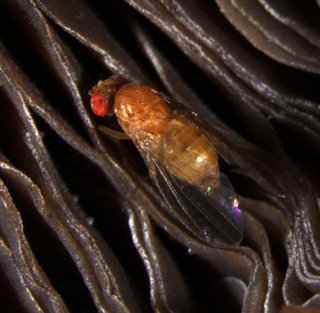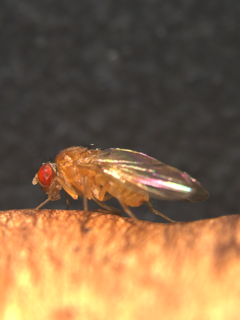
Drosophila is a genus of flies, belonging to the family Drosophilidae, whose members are often called "small fruit flies" or pomace flies, vinegar flies, or wine flies, a reference to the characteristic of many species to linger around overripe or rotting fruit. They should not be confused with the Tephritidae, a related family, which are also called fruit flies ; tephritids feed primarily on unripe or ripe fruit, with many species being regarded as destructive agricultural pests, especially the Mediterranean fruit fly.

The Drosophilidae are a diverse, cosmopolitan family of flies, which includes species called fruit flies, although they are more accurately referred to as vinegar or pomace flies. Another distantly related family of flies, Tephritidae, are true fruit flies because they are frugivorous, and include apple maggot flies and many pests. The best known species of the Drosophilidae is Drosophila melanogaster, within the genus Drosophila, also called the "fruit fly." Drosophila melanogaster is used extensively for studies concerning genetics, development, physiology, ecology and behaviour. Many fundamental biological mechanisms were discovered first in D. melanogaster. The fruit fly is mostly composed of post-mitotic cells, has a very short lifespan, and shows gradual aging. As in other species, temperature influences the life history of the animal. Several genes have been identified that can be manipulated to extend the lifespan of these insects. Additionally, Drosophila subobscura, also within the genus Drosophila, has been reputed as a model organism for evolutionary-biological studies, along with D. sechellia for the evolution of host specialization on the toxic noni fruit and Scaptomyza flava for the evolution of herbivory and specialist on toxic mustard leaves.

The Drosophilinae are the largest subfamily in the Drosophilidae. The other subfamily is the Steganinae.

The paraphyletic subgenus Sophophora of the genus Drosophila was first described by Alfred Sturtevant in 1939. It contains the best-known drosophilid species, Drosophila melanogaster. Sophophora translates as carrier (phora) of wisdom (sophos). The subgenus is paraphyletic because the genus Lordiphosa and the species Hirtodrosophila duncani are also placed within this subgenus.
FlyBase is an online bioinformatics database and the primary repository of genetic and molecular data for the insect family Drosophilidae. For the most extensively studied species and model organism, Drosophila melanogaster, a wide range of data are presented in different formats.

The immigrans-tripunctata radiation is a speciose lineage of Drosophila flies, including over 300 species. The immigrans-tripunctata radiation is a sister lineage to most other members of the subgenus Drosophila. A number of species have had their genomes or transcriptomes sequenced for evolutionary studies using Drosophila.

The genus Zaprionus belongs to the family fruit fly Drosophilidae and is positioned within the paraphyletic genus Drosophila. All species are easily recognized by the white longitudinal stripes across the head and thorax. The genus is subdivided in two subgenera, based on the presence of an even or odd number of white stripes. The species of the genus can be found in Africa and Southern Asia. One species, Zaprionus indianus, has invaded the New World.
The Drosophila saltans species group contains 21 described fly species, all of which are found in the neotropical region. It is one of the seven species groups in the subgenus Sophophora, the others being the D. willistoni, D. melanogaster, D. obscura, D. dispar, D. fima, and D. dentissima groups. The D. saltans species group is most closely related to the D. willistoni subgroup. The species are placed into five subgroups: the D. s. cordata, D. s. elliptica, D. s. parasaltans, D. s. saltans, and D. s. sturtevanti subgroups. It is thought that, like the D. willistoni species group, the D. saltans species group originated in tropical North America, colonized South America, and then diversified prior to the formation of the Isthmus of Panama. Some of these may have migrated back to North America within the last 4.5 million years ago (mya), and consequently the relationship between the species is unresolved due to the short amount of time that has elapsed since their divergence points.
Metavirus is a genus of viruses in the family Metaviridae. They are retrotransposons that invade a eukaryotic host genome and may only replicate once the virus has infected the host. These genetic elements exist to infect and replicate in their host genome and are derived from ancestral elements unrelated from their host. Metavirus may use several different hosts for transmission, and has been found to be transmissible through ovule and pollen of some plants.

Drosophila neotestacea is a member of the testacea species group of Drosophila. Testacea species are specialist fruit flies that breed on the fruiting bodies of mushrooms. These flies will choose to breed on psychoactive mushrooms such as the Fly Agaric Amanita muscaria. Drosophila neotestacea can be found in temperate regions of North America, ranging from the north eastern United States to western Canada.

The Drosophila testacea species group belongs to the Immigrans-tripunctata radiation of the subgenus Drosophila, and contains 4 species: Drosophila putrida, Drosophila neotestacea, Drosophila testacea, and Drosophila orientacea. Testacea species are specialist mushroom-feeding flies, and can metabolize toxic compounds in Amanita mushrooms. The Testacea species group is studied for its specialist ecology, population genetics, and bacterial endosymbionts. The North American species Drosophila neotestacea is perhaps the best-studied of the group for its interactions with parasitic wasps and nematodes, bacterial endosymbionts, and trypanosomatid parasites. Of note, selfish X chromosomes have been discovered in three of the four Testacea group species.
Drosophila bizonata is a species of fruit fly in the Drosophila bizonata species group in the Immigrans-tripunctata radiation of the Drosophila subgenus. Drosophila bizonata is found in Japan. D. bizonata breeds and feeds exclusively on mushrooms, and has a high tolerance for ibotenic acid, a toxic compound found in Amanita mushrooms.
The Drosophila cardini species group belongs to the subgenus Drosophila of vinegar flies in the Immigrans-tripunctata radiation of the subgenus Drosophila. The closest relatives of Cardini species include Drosophila bizonata, Drosophila quinaria, and Drosophila testacea species groups, comprising mushroom-feeding flies. Cardini group species likely derived their more general feeding ecology from a mushroom-feeding ancestor, an evolutionary transition in feeding similar to Drosophila quinaria.

Mushroom-feeding Drosophila are a subset of Drosophila flies that have highly specific mushroom-breeding ecologies. Often these flies can tolerate toxic compounds from Amanita mushrooms.
The Drosophila angor species group is a species group of fruit flies in the subgenus Drosophila.
The Drosophila robusta species group is a species group of fruit flies in the subgenus Drosophila.
The Drosophila melanica species group is a species group of fruit flies in the subgenus Drosophila.
The Drosophila quadrisetata species group is a species group of fruit flies in the subgenus Drosophila.
The Drosophila repleta species group is a species group of fruit flies in the subgenus Drosophila.
The Drosophila virilis species group is a species group of fruit flies in the subgenus Drosophila.







